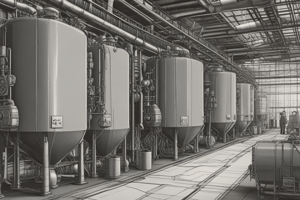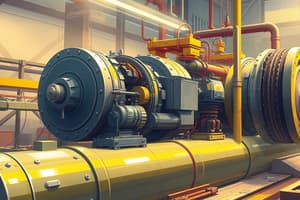Podcast
Questions and Answers
What do workplace safety policies and procedures provide?
What do workplace safety policies and procedures provide?
- A clear framework for decision-making
- Guidelines for employee behavior
- Safety standards for managing daily operations
- All of the above (correct)
Which of the following is the primary goal of industrial housekeeping?
Which of the following is the primary goal of industrial housekeeping?
- To ensure facilities are aesthetically pleasing
- To increase production speed
- To reduce the amount of dangerous dust particles (correct)
- To minimize employee interaction
What is the aim of workplace safety training?
What is the aim of workplace safety training?
- To provide employees with the skills to perform their work safely (correct)
- To minimize contact between managers and employees
- To increase production quotas
- To reduce the amount of breaks workers take
What does PPE protect individuals from?
What does PPE protect individuals from?
Which of the following is a basic form of PPE for the eyes?
Which of the following is a basic form of PPE for the eyes?
What should be established for emergency situations?
What should be established for emergency situations?
What is the purpose of evacuation drills?
What is the purpose of evacuation drills?
What is a key consideration for accessible evacuation routes?
What is a key consideration for accessible evacuation routes?
What is the first primary goal of first aid?
What is the first primary goal of first aid?
What is one of the responsibilities that employers have based on OSHA regulations?
What is one of the responsibilities that employers have based on OSHA regulations?
What action must employers take to address workplace hazards?
What action must employers take to address workplace hazards?
Employers must adhere to OSHA's standards. What areas are covered?
Employers must adhere to OSHA's standards. What areas are covered?
What type of fires are water extinguishers designed for?
What type of fires are water extinguishers designed for?
What class of fire is a carbon dioxide (CO2) extinguisher used on?
What class of fire is a carbon dioxide (CO2) extinguisher used on?
Which class(es) of fire can be put out using a dry powder extinguisher?
Which class(es) of fire can be put out using a dry powder extinguisher?
What type of fires are wet chemical extinguishers designed for?
What type of fires are wet chemical extinguishers designed for?
What is the purpose of using a foam fire extinguisher?
What is the purpose of using a foam fire extinguisher?
Foam fire extinguishers are effective on which classes of fire?
Foam fire extinguishers are effective on which classes of fire?
According to the document, what should workers be trained on regarding hazard control?
According to the document, what should workers be trained on regarding hazard control?
What must employers do concerning tools and equipment in the workplace?
What must employers do concerning tools and equipment in the workplace?
Flashcards
Housekeeping in Industries
Housekeeping in Industries
Ensuring facilities, equipment, and access routes are well-maintained.
Workplace Safety Policies
Workplace Safety Policies
Documents that guide decisions, behavior, and responsibilities.
Workplace Safety Training
Workplace Safety Training
Equipping employees with the knowledge and skills for safe work practices.
Personal Protective Equipment (PPE)
Personal Protective Equipment (PPE)
Signup and view all the flashcards
Emergency Evacuation Procedures
Emergency Evacuation Procedures
Signup and view all the flashcards
First Aid
First Aid
Signup and view all the flashcards
Three primary goals of First Aid
Three primary goals of First Aid
Signup and view all the flashcards
OSHA's Role
OSHA's Role
Signup and view all the flashcards
Employer Responsibilities
Employer Responsibilities
Signup and view all the flashcards
Types of fire extinguishers
Types of fire extinguishers
Signup and view all the flashcards
How Water Extinguishers work
How Water Extinguishers work
Signup and view all the flashcards
How CO2 Extinguishers work
How CO2 Extinguishers work
Signup and view all the flashcards
How Dry Powder Extinguishers work
How Dry Powder Extinguishers work
Signup and view all the flashcards
How Wet Chemical Extinguishers work
How Wet Chemical Extinguishers work
Signup and view all the flashcards
How Foam Extinguishers work
How Foam Extinguishers work
Signup and view all the flashcards
Class A Fire
Class A Fire
Signup and view all the flashcards
Class B Fire
Class B Fire
Signup and view all the flashcards
Class C Fire
Class C Fire
Signup and view all the flashcards
Class F Fire
Class F Fire
Signup and view all the flashcards
Providing a Safe Workplace
Providing a Safe Workplace
Signup and view all the flashcards
Study Notes
Housekeeping in Industries
- In industries ensures facilities, equipment, work areas, and access routes are kept in good condition.
- The primary goal of industrial housekeeping is to reduce dangerous dust particles, fumes, and other emissions within a facility.
- Success in workplace safety housekeeping involves stocking and maintaining PPE's.
- Success in workplace safety housekeeping involves mitigating slip, trip, and fall accidents .
- Success in workplace safety housekeeping involves addressing fire hazards, managing dust and waste, and stopping hazardous materials transfer.
- OSHA checklists are used for safety culture inspections.
- Regularly evaluate and maintain walkways, surfaces, lighting, storage, and sanitation facilities.
- A checklist covers the storage, maintenance of tools/equipment, materials handling, and proper waste disposal.
Workplace Safety Policies and Procedures
- Policies and procedures are the foundation of a compliant workplace providing a clear framework for decision-making and guiding employee behavior.
- Implementing OHS/WHS policies ensures all employees follow clear guidelines for consistency, reducing confusion and promoting harmony.
- Compliance with policies and procedures helps stay ahead of regulatory requirements, avoiding fines, legal issues, and stress.
- Efficiency is achieved through well-defined procedures that streamline operations, save time, and boost productivity.
- WHS policies and procedures manage hazards, prevent accidents and protect businesses from costly downtime.
Workplace Safety Training
- Workplace safety training provides the workforce with the knowledge and skills to perform their work safely.
- The training includes hazard recognition, proper use of equipment, emergency response procedures, and promoting a safety culture.
- Training involves instructing workers on hazard control concepts and techniques, including the hierarchy of control.
- Proper use of work practices and administrative controls are part of training.
- Training includes when and how to wear required personal protective equipment.
Personal Protective Equipment (PPE)
- PPE refers to protective clothing for the eyes, head, ears, hands, respiratory system, body, and feet.
- PPE protects individuals from injury and infection by minimizing exposure to chemical, biological, and physical hazards.
- PPE serves as the final line of defense when engineering and administrative controls are insufficient in reducing or eliminating risks.
- Basic PPE includes glasses/goggles for eye protection.
- Basic PPE includes ear muffs for hearing protection.
- Basic PPE includes safety/water boots for foot protection.
- Basic PPE includes hard hats for head protection.
- Basic PPE includes respirators for respiratory protection.
- Basic PPE includes chemical/body suits for body protection.
- Basic PPE includes face shields for face protection.
Emergency Evacuation Procedures
- Establish clear communication protocols for emergency situations.
- Promptly inform all individuals about the need for immediate evacuation using alarms, intercoms, or other systems.
- Establish a predetermined emergency exit route.
- Clearly mark designated emergency exits.
- Ensure individuals know the locations of exits and escape routes.
- Display evacuation maps and signage in easily visible locations.
- Provide visual aids to guide individuals through evacuation routes and highlight assembly points.
- Training an emergency response team coordinates evacuations.
- Designated individuals guide others, conduct head counts, and communicate with emergency services.
- Conduct regular drills to familiarize occupants with procedures.
- Simulate emergency scenarios to test evacuation plans and identify areas for improvement.
- Evacuation routes must be accessible to individuals with disabilities, providing alternate routes and assistance options.
- Strategically select the Assembly Point outside the premises for easy access away from hazards, with ample space for head counts.
First Aid Procedure
- Understanding basic first aid is essential for a safe workplace.
- Trained employees can respond quickly and appropriately to workplace injuries or medical conditions.
- First aid is the necessary temporary assistance an injured person needs until professional medical care can be provided.
- The three primary goals of first aid are to preserve life, prevent further injury, and promote recovery.
OSHA Compliant Regulations
- Standards are set and enforced to reduce workplace hazards, providing training, outreach, education, and assistance to employers and employees.
- Employers must provide a safe workplace, comply with standards, and protect employees from harm and injury.
- Part of the employer responsibilities involves providing a workplace free from serious known hazards.
- Employer responsibilities involve examining workplace conditions to ensure they conform to applicable OSHA standards.
- Employer responsibilities include ensuring employees have and use safe tools and equipment, meeting reporting requirements and maintaining records.
- Employee responsibilities involve submitting to OSHA inspectors.
Employer Responsibilities
- Employers must identify and eliminate serious recognized hazards, conducting regular safety assessments and implementing measures to address risks.
- Employers must adhere to OSHA's specific safety and health standards which vary by industry, covering fall protection, hazardous materials, machine safety, and ergonomics.
- Ensure that all tools, machinery, and equipment used in the workplace are safe and properly maintained, with employees trained in their proper usage to prevent accidents.
- Employers must maintain accurate records of workplace injuries, illnesses, and incidents
- Required to report serious injuries, fatalities, or significant workplace hazards to OSHA within specified time frames.
- Employers must cooperate with OSHA inspections, which can be conducted to ensure compliance or investigate accidents, complaints, or reports of unsafe conditions.
- Employers should prepare for these inspections by keeping all safety documentation and protocols up to date.
Types of Fire Extinguishers
- Classes of Fire and Description is important in safely and properly extinguishing different sources.
Water Extinguisher
- Used for Class A fires involving solid combustible materials like wood, paper, and cloth.
- Water extinguishers cool burning materials by removing the heat needed for combustion, and they're unsuitable for electrical or liquid fires.
Carbon Dioxide (CO2) Extinguisher
- Used for Class B fires, which are flammable liquids like petrol, oil, and paint, in addition to electrical fires.
- CO2 extinguishers displace oxygen, smothering the fire and leave no residue and are ideal for use on electrical equipment.
Dry Powder Extinguisher
- Used for Class A, B, and C fires which include flammable gases like propane or butane
- Extinguishers create a barrier between the fuel and oxygen or by interrupting the chemical reaction, but can cause mess and visibility issues.
Wet Chemical Extinguisher
- Used for Class F fires which are cooking oils and fats, e.g., in kitchens.
- Extinguishers cool the fire and form a soapy layer over the burning fat, preventing re-ignition.
Foam Fire Extinguisher
- Used for Class A and B fires.
- Extinguishers smother the fire and prevent re-ignition by creating a foam layer, and are effective on both flammable liquids and solid fires.
Studying That Suits You
Use AI to generate personalized quizzes and flashcards to suit your learning preferences.





